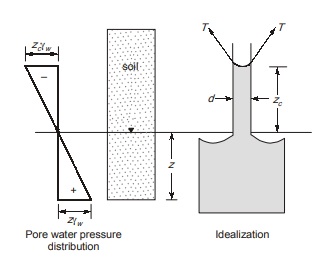Effective Stresses
PHYSICAL SIGNIFICANCE OF EFFECTIVE STRESSES
Consider a fully saturated soil. Let us take a wavy plane x-x passing through the soil.
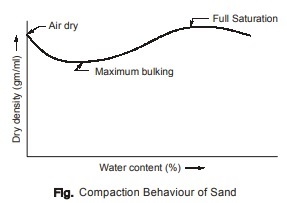
The cutting plane through the soil at any depth must cut through many mineral particles. But the conditions of stress at the point of contact of particles, rather than within them, are of relevance in consideration of strains, shear resistance etc. The wavy plane shown in the figure above is really indistinguishable from the true horizontal plane because of small size of particles. Area of contact of soil grain, As , is very small fraction of the total surface area. The entire area of this horizontal plane can be taken to pass through the pore water. Therefore the “effective stress” is really a misnomer for the reason that effective stress is really not the stress at particle contacts. The actual contact stresses are very high as the contact area is very small. Whereas the effective stress is sum of the contact forces divided by gross area. This is the reason why effective stress is not physically meaningful and cannot be measured.
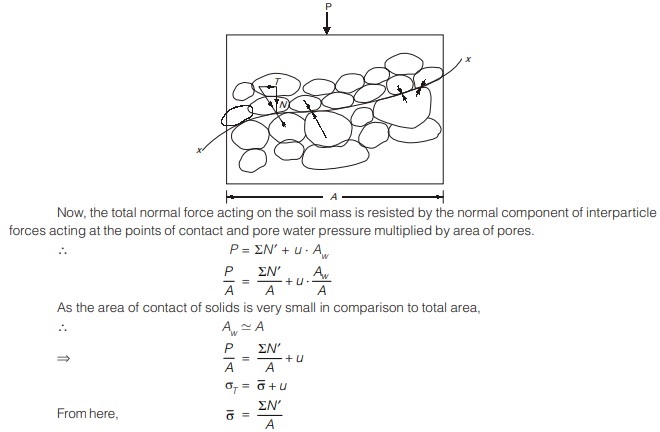
CAPILLARITY IN SOILS
As we know, the rain water percolates into the ground under the influence of gravity and gets stored in the soil pores, over an impervious stratum, in the form of ground water reservoir.
The upper surface of the zone of full saturation of the soil is called the water table or phreatic surface. At the water table, the ground water is subjected to atmospheric pressure. In other words, the pore pressure is zero.
Soil water can exist in three zones, which are
- Zone-I (Submerged Zone): This zone exist below the ground water table. The soil in this zone is in submerged condition and pore pressure is hydrostatic i.e. positive.
- Zone-II (Capillarity Zone): If gravity was the only force acting on the percolating water and taking it downward, then the soil above the water table would be completely dry. But it is not so in actual practice. Soil in this zone is completely saturated upto some height above the water table. This phenomenon of rising water in soil is known as capillarity in soils. Capillary water is held above the water table by surface tension which is the fluid property.
- Zone–III (Zone of Aeration): Above the capillarity zone and upto a certain height, there exist a zone called the zone of aeration, in which the soil is able to retain small water droplets, surrounded on all sides by air. This water is known as contact moisture or hygroscopic water. The contact moisture is retained by the soil against the gravity drainage by the action of capillary.
Capillary Rise in Soils
We can get an understanding of capillarity in soil by idealizing the continuous void spaces as capillary tubes. Consider a single idealized tube as shown in figure below.
The surface tension (force) pulls the water upward till height hc, at which weight of water in the column is in equilibrium with the magnitude of the surface tension force.
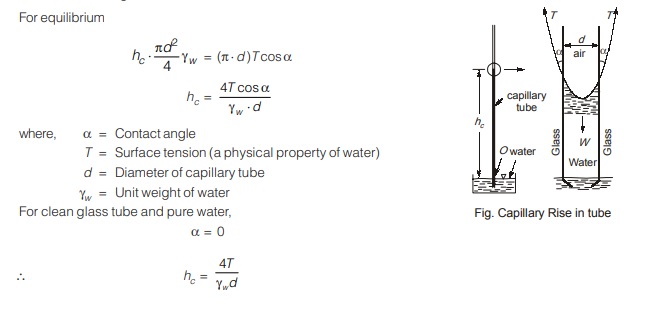
Because of the complex nature of the soil, a theoretical prediction of capillary rise in soil is not possible. Terzaghi and Peck suggested an approximate relationship to find capillary rise in-situ.
hc(cm) = C/eD10
where, C = Empirical constant; the value of which depends on the shape and surface impurities of the grains and lies between 0.1 and 0.5 cm2.
e = Void ratio
D10= Effective grain size
Two soils having same D10 can have different capillary rise depending on soil structure and fabric geological history.
Capillary Pressure
Capillary water rises against gravity and is held by surface tension. Therefore the capillary water exerts a tensile force on soil and resulting negative pressure of water (Capillary pressure) creates attraction between the particles.
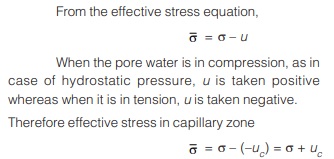
It means that due to capillarity in soils, effective stress increases. The most important consequence of increase in σ is an increase in shearing resistance of the soil mass. Due to this reason, one can walk comfortably on a sand beach adjacent to sea [a patch falling within the capillary zone] but not on the dry sand some further distance away from the sea, where no capillary rise is there due to which there is much less bearing power. During tides these menisci breaks, therefore this temporarily induced strength will be lost and anyone walking on this surface feel the ground sink under his feet.